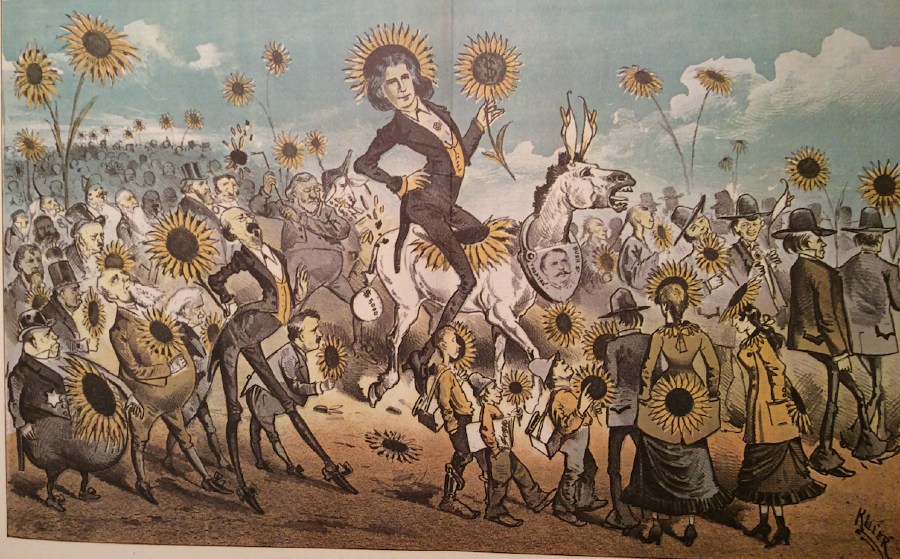 |
| Cartoon depicting Oscar Wilde's 1882 visit to San Francisco, from The Wasp, 31 March 1882. Public Domain via Wikimedia. |
 Intentions: The Decay of Lying, Pen, Pencil and Poison, the Critic as Artist, the Truth of Masks by Oscar Wilde
Intentions: The Decay of Lying, Pen, Pencil and Poison, the Critic as Artist, the Truth of Masks by Oscar WildeMy rating: 5 of 5 stars
This collection of dialogues and essays demonstrates Oscar Wilde's aesthetic, but also his vast knowledge of the classics, Shakespeare, and other great things in nineteenth-century Anglo art, literature, architecture, and theatre. Three pages into The Decay of Lying and one has been exposed to Aristotle, William Morris, and Ralph Waldo Emerson. He uses a form of the "iceberg" principle (later perfected by Hemingway) that demonstrates his knowledge without appearing to be name dropping. It is one thing to mention Aristotle, Morris, and Emerson as part of Vivian's critique of nature; quite another to append one's own aesthetic to the name dropping that leaves no doubt as to the author's learning. For instance, William Morris once said:
Have nothing in your houses that you do not know to be useful or believe to be beautiful.
Wilde, in discussing nature versus art, mentions Aristotle (p. 3):
Nature has good intentions, of course, but as Aristotle once said, she cannot carry them out.
Vivian is discussing his preference for the indoors, and says (p. 4):
Why, even Morris' poorest workman could make you a more comfortable seat then the whole of Nature can... If Nature had been comfortable, mankind would never have invented architecture, and I prefer houses to open air.
This first part of the introduction is then neatly wrapped up with reference to Vivian (p. 5) writing the word "Whim" over the door of his library, echoing Emerson doing similar in his famous essay Self-Reliance. What does this all mean? It sets out several themes that thread through these five dialogues and essays. First is the interaction of art and nature in the human spirit. Second is contradiction. Vivian doesn't want to go outside, until he does. Vivian thinks writing is a waste of effort. But he is writing an article. In the final paragraph of the collection, Wilde writes:
Not that I agree with everything I have said in this essay. There is much with which I entirely disagree. The essay simply represents an artistic standpoint, and in aesthetic criticism, attitude is everything. For in art there is no such thing as a universal truth. A Truth in art is that whose contradictory is also true.
Third is the rhythm of life and the pursuit of human excellence. Wilde's characters in the dialogues go from contradictory point to contradictory point. In the essays we learn how ill-discipline and ignoring our intuition can lead to trouble (for instance, the poisoner leaves his ground-floor curtain open and is instantly recognised from the street); how Shakespeare used architecture and costume to make a point (as opposed to the theatrical archaeologists who point out Shakespeare's character's anachronistic raiment); how one moment we are focused, the next bored, even depressed, but we can be humorous, witty, intelligent, and dull. The dialogues read like a moment of intense thought that begins out of boredom and ends in boredom with thought. An indoor conversation is the scene of energy, but after talking "long enough", the outdoors beckons:
Egotism itself, which is so necessary to a proper sense of human dignity, is entirely the result of indoor life.
It is unsurprising that Oscar Wilde is so well-read and witty. After all, he was a graduate of Oxford at a time when only the elite or those with elite patronage could dream of studying there. Yet there is an intense use of Plato's form of dialogue, an interesting blend of self-reliance and pompousness, intensity appearing indoors (even within Shakespeare's Globe Theatre), and the outdoors being a place of leisure (for the well-to-do, at least!). Yet the point of contradiction is not to be dishonest, but, through art, to bring to Nature the human experience:
The final revelation is that Lying, the telling of beautiful untrue things, is the proper aim of Art.
I recall in high school, when studying English literature, the teacher would ask: "What does the author mean by this or that?" to which I would say, "How should I know? And how do you know if you didn't ask them?" Logical to an egotistical teenager, to be sure, but hardly intelligent. And now? It would take several re-readings of these dialogues and essays and some intense study into Wilde's life at the point in time of writing these works to discover more. Yet, armed with the knowledge of reading given to me by Harold Bloom, Mortimer Adler, Italo Calvino, and Theodore Roosevelt (to name but a few), I think I can safely tell my teenage self that, contradictory to what I thought then, one can interpret and learn from the writings of others, even if the lessons learnt were never intended. And if Art cannot deliver such lessons, what other medium can?
View all my reviews
 Donate
Donate




